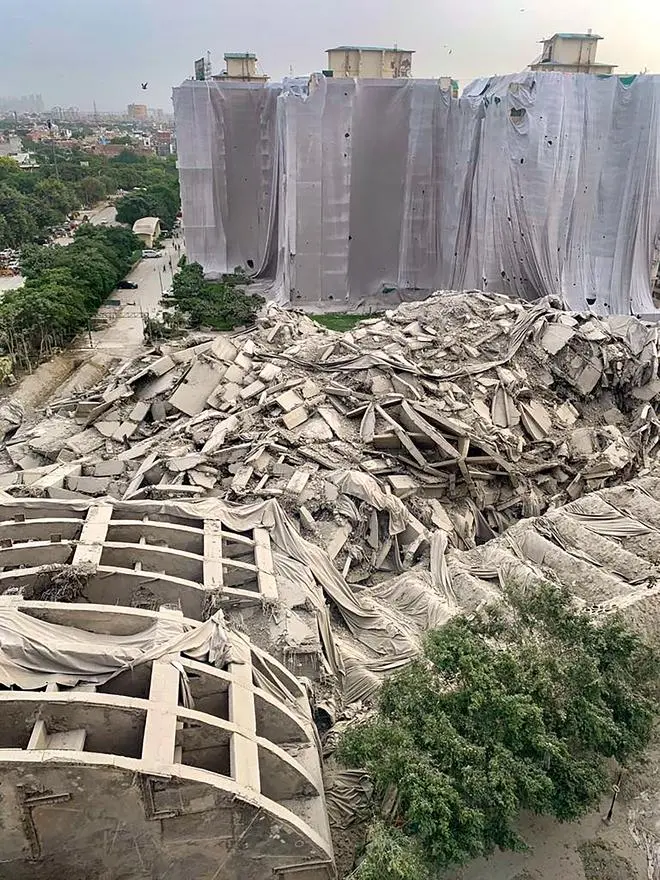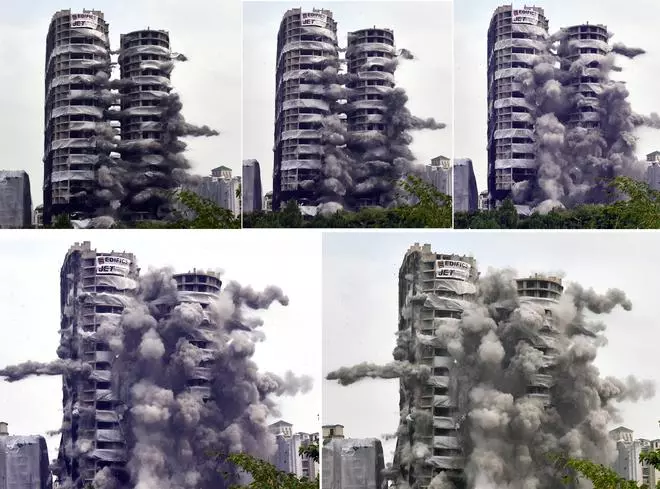With the successful demolition of the Supertech twin towers here on Sunday, India has joined the club of countries that have razed buildings taller than 100 metres, Joe Brinkman of South African firm Jet Demolitions said.
The illegal twin towers in Noida's Sector 93A were grounded by waterfall implosion technique in a matter of 12 seconds, Brinkman told reporters.
The Apex (32 storeys) and Ceyane (29 storeys) towers of Supertech had a height of 103 metres each, according to officials.
Mumbai-based Edifice Engineering, which was tasked with the demolition, had selected Jet Demolitions as its expert partner for the job.
The two had together previously demolished four residential complexes in Maradu municipal area of Kochi, Kerala in a similar fashion.
Debris disposal
“India and Edifice have now joined the 100-metre club of countries which have buildings over this height that have been demolished and that too with residential buildings standing so close to them, making the project extremely challenging," Brinkman, 62, said, heaping praises on the Edifice-Jet team.
"All credit goes to the entire team," he said.
Jet Demolitions holds a distinguished position globally for demolition works. In November 2019, the firm had grounded the 108-metre-tall Bank of Lisbon building in Johannesburg within a few seconds in an eye-popping event and ensured that a structure barely seven metres next to it was safe too.

Debris of the demolished Supertech’s twin towers, in Noida, Monday, Aug. 29, 2022. The illegal twin towers were grounded by waterfall implosion technique leaving approximately 80,000 tonnes of debris out of which around 50,000 tonnes have been absorbed in the basements while the remaining would be disposed of in 90 days, according to officials. | Photo Credit: PTI
Brinkman said the whole process for demolishing the Noida twin towers took 12 seconds.
He said the team's first priority was to ensure that there were no injuries to people during the implosion and no structural damages caused to any of the buildings around.
He added that very few buildings taller than 100 metres have been demolished in a controlled manner across the world.
Edifice Engineering partner Utkarsh Mehta described Brinkman as the "mastermind" of the successful demolition.
Mehta said around 35,000 cubic metres or approximately 80,000 tonnes of debris was left after the demolition.
Around 50,000 tonnes of it has been absorbed in the basements of the now-demolished towers while the remaining would be disposed of in 90 days, he said.
“We will have to coordinate with the Emerald Court and ATS Village societies for the disposal since the debris would have to be first processed at the site only and then it would be taken to construction and demolition waste processing centres.
“Coordination would be needed for fixing the timing for work at the site to cause least disturbance to residents,” said Mehta.
Challenging process
Jigar Chheda, another Edifice partner, said they took a full six months to plan the clean execution of the demolition and the whole exercise was a “very challenging” process.
“Days and nights went into the preparation for this day. Over 9,000 holes were drilled for explosives in the two buildings; they had to be most accurate and all this was challenging,” Chheda told PTI.

A controlled implosion demolishes the 100-metre-high residential “Twin Towers” at Noida in Uttar Pradesh on August 28, 2022. | Photo Credit: KAMAL NARANG
“Getting permission from all authorities concerned, coordinating with multiple agencies, and convincing residents of safety were key effort areas,” he said.
Mayur Mehta, project manager for Edifice, said 9,642 holes were drilled and 3,700 kgs of explosive were used for the demolition.
“The types of explosives used were Solar coal – with 6 gm, 10 gm, 20 gm, and 80 gm mass. Electric detonators, shock tubes and emulsions were also used. The tubes were placed in a way that some had a 0.5-millisecond explosion capacity, while others had a 7,000-millisecond capacity,” he added.
Edifice officials said nine metres of the boundary wall of ATS Village comprising some 900 bricks was damaged.
Several window panes in Emerald Court as well as ATS Village were cracked and they had started the process to replace them with new ones shortly after inspection at the site Sunday evening.










Comments
Comments have to be in English, and in full sentences. They cannot be abusive or personal. Please abide by our community guidelines for posting your comments.
We have migrated to a new commenting platform. If you are already a registered user of TheHindu Businessline and logged in, you may continue to engage with our articles. If you do not have an account please register and login to post comments. Users can access their older comments by logging into their accounts on Vuukle.